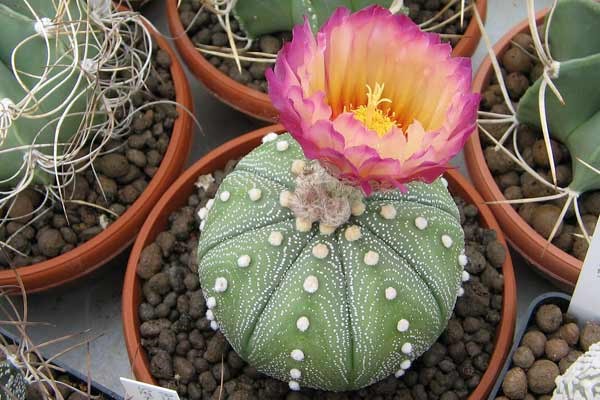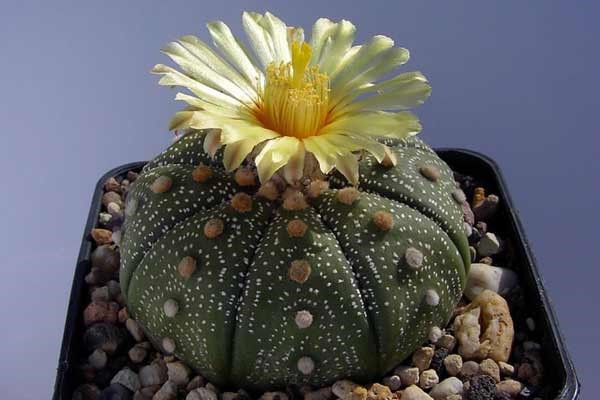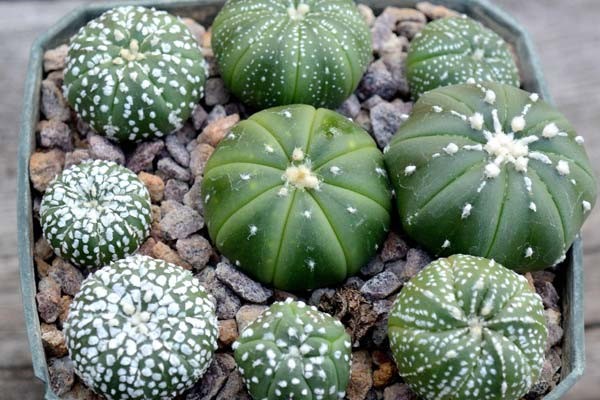Star Cactus Care | Astrophytum Asteria Full Guide

Star Cactus, also known As Sand Dollar Cactus, Sea Urchin Cactus, and star peyote, is a small and round succulent native to Mexico and some parts of Texas. Scientifically named Astrophytum Asteria, the spineless Star Cactus has a growing popularity among gardeners around the world.
Although its popularity does not promise easy care, you can grow it as well, as long as you can provide what they need. In the following, we are going to know the Star Cactus succulent better, and tell you all you need to know for growing and caring for this highly decorative houseplant.
Star Cactus Succulent Description and Characteristics
Astrophytum Asteria is a small and adorable succulent; it can grow up to 6 cm (2.4 in) in height and 15 cm (6 in) in width. But in its natural habitat, the Star Cactus succulent can grow up to 6 feet (1.8 m). In fact, this plant is the fastest-growing and tallest species of the Astrophytum genus.
It has a greenish-brown body, consisting of 7 to 10 ribs and a woolly areola in the middle. These ribs give the Sand Dollar Cactus its signature cylinder-like shape. As the cactus ages, the number of these ribs increases, and the plant takes on a perfectly round shape.
Depending on the Star Cactus succulent specimen, some portions of the plants may be covered in white stripes, wool, dots, or hypnotic patterns. But that is not the only characteristic that changes according to the specimen; the Star Cactus flower is another one.
Star Cactus Flower
Every cactus enthusiast is always curious about the flower of his/her next succulent. In terms of flowers, the Sea Urchin Cactus is far from disappointing us.
The Star Cactus flower color varies from white to subtle shades of cream and yellow. Some Star Cactus flowers also have a dash of orange and red at the base; mainly Astrophytum Myriostigma and Astrophytum Capricorne.
In the late spring, the flowers turn into oval berries in various colors including green, red, pink, or even gray. If you already have an Astrophytum Asteria, you can collect the tiny seeds from the flowers and use them for propagation.

Star Cactus Care
With enough patience and love, you will be able to grow this plant successfully; and you may also be blessed with vibrant and eye-catching Star Cactus flowers. Here are all the requirements of this ornamental succulent:
Light
This is not a cactus with a fast growth rate, but it thrives best in a spot with light shade or partial sun. If you place it in a spot with some shade, keep in mind that its body color will become darker. If you want to grow your Sand Dollar Cactus indoors and do not have such a spot, use a grow light.
Temperature
Similar to many other cacti, the Star Cactus is not cold-hardy. However, it can survive temperatures as low as 20 degrees Fahrenheit (but only for short periods of time). Remember that the plant can tolerate this condition, as long as it is dry during the winter. Moisture makes the Astrophytum Asteria less cold-hardy during this season.
In winter, the Sea Urchin Cactus will become dormant as well, meaning that it requires low temperatures between 40 to 60 degrees Fahrenheit. If keeping indoors, place the plant in a cool area and away from heat dispensing objects to contribute to its dormancy. But it is possible that the Star Cactus does not experience winter dormancy indoors.
Overall, you may not need to treat your cactus differently during the winter when growing indoors, as temperatures are more consistent year-round.
Water
The Star Cactus succulent is considerably sensitive to overwatering. This leads to common problems among succulents such as root rot. Since this disease only shows itself when your cactus is beyond help, irrigate your plant with caution.
Keeping its natural habitat in mind (extremely dry with infrequent rain):
- Water infrequently between March and October, as it becomes dormant.
- Stop watering around October, as the temperature decreases.
- Start watering in spring, as it begins to warm up.
Star Cacti can go several weeks or more without water, bet check them at least once per week. And if the soil is dry, water them.
Soil
Star Cactus care has many similarities to other succulents. One of them is the need for well-draining soil. Such soils let the cacti simulate their preferred dry lifestyle, by letting excess water drain away quickly.
Grittier soil mixes with gravel, coarse sand, bark, and perlite are among your best options. Do not use soil mixes with coconut coir, peat moss, or clay. These water-retaining ingredients will cause root rot sooner than you would expect.
In case you prefer making your own soil mix, simply combine a high-quality cactus soil with a gritty mix.

Humidity
In addition to excess water, Astrophytum Asteria is also sensitive to humidity (think about its natural habitat once more). So if there is a humidifier in your home, keep your cactus away from it as much as possible.
Potting and Repotting
An important part of Star Cactus care is how to transplant it correctly. While choosing the right soil, you should also find a suitable container for your green friend.
First of all, the container/pot should have drainage holes so the excess water can escape it. Also, we recommend not to line the bottom of the pot with rocks or gravel. It does not help drainage. Instead, keeps the water closer to the cactus’ roots, leading to the risk of root rot.
About the size, stay away from large pots. Such containers encourage overwatering and retained moisture. Which as we established, is not good in Star Cactus care.
You can repot your succulent at the beginning of every growing season, with a relatively larger pot. It is better if you change the soil as well.
Feeding
In addition to regular repotting, the star peyote enjoys feeding during its growing season. But when the winter arrives, stop adding fertilizers.
Pests and Diseases
Root rot aside, Astrophytum Asteria is prone to common succulent pests like scale and mealybugs. Since preventing is much easier than treating, check your plant regularly to make sure there are no infestations moving in.

Propagating Astrophytum Asteria
As mentioned, you can propagate this plant using Star Cactus seeds found in their flowers. All you need to do is simply remove the seeds from dried flowers, and plant them like you plant any other store-bought seed.
The seeds are very fragile, so treat them gently before planting. Also, plant them in soil quickly after collecting, since they have a short life on their own and fewer chances to germinate.
Fill a tray or container with a fresh cactus mix, place the Star Cactus seeds, and cover them with a thin layer of potting soil. Seal the tray/container with plastic to retain humidity and heat.
Once the seeds have germinated, remove the plastic and move the tray/container to a sunny and warm location gradually. After a few weeks, you can transplant each baby Astrophytum Asteria into individual pots.
Propagating using seeds is the easiest method, even if you are a beginner gardener. So if you can find some high-quality seeds, start propagating!
Star Cactus Facts
- Astrophytum Asteria is considered a threatened species.
- The Star Cacti are not poisonous to humans and animals, but some of them can be pretty prickly.
- Similar to their body pattern, it is interesting to know that their flowers, seeds, and fruits are also different among different species.
- Thanks to their unique shape and colorful flowers, the Star Cacti are excellent companions to other houseplants including succulents, cacti, etc.
- This plant not only survives but also does well with minimal care as long as they receive plenty of full sunlight and are placed in a warm environment.
- In this post:
- Star Cactus Succulent Description and Characteristics
- Star Cactus Care
- Propagating Astrophytum Asteria
- Star Cactus Facts



